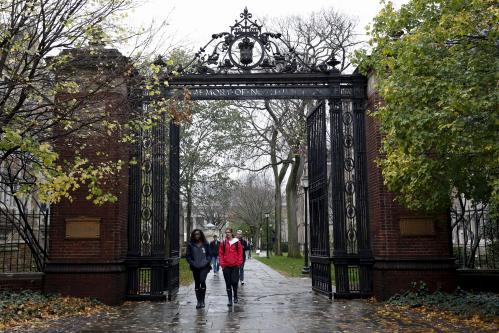This article was originally published in the Financial Times on September 13, 2019.
When Michael Young coined the term “meritocracy” in 1958, he worried it would not be taken seriously, because it mashes together one Latin and one Greek word. (This is the kind of thing British academics worried about in those days). As it turned out, that was not the problem. Young’s novelised sociology The Rise of the Meritocracy tried to alert readers to the dangers of a world in which merit — “IQ plus effort” — would determine rank. Young’s new word was adopted almost immediately. His warnings were ignored.
On the face of it, the idea that rewards should go to the best — to the meritorious — is appealing. Just as the winner of the Wimbledon tennis championships ought to be the one who plays the best, so the newly appointed chief executive should have the most appropriate skills and experience. Certainly, it seems better than an aristocracy, where jobs and status simply fall into the laps of those who win the lottery of birth.
But as Daniel Markovits reminds us, meritocracy comes at a price too. The society-wide game of snakes and ladders that is created by meritocracy can be stressful. Just ask the parents who spend their weekends ferrying their kids from football match to maths tutor; or the students popping pills to maximise their test scores and grades, in order to get into the best college; or the senior executives working 100 hours a week to secure their place at the top of the corporate pyramid.
The Meritocracy Trap is well-timed. Given the rise of inequality in most economically advanced nations, the question of whether meritocracy is a blessing or a curse is being asked with renewed urgency. Is meritocracy a liberating ideal or an engine of inequity?
Markovits, a professor at Yale Law School, vividly describes the growing gap between the “gloomy” jobs on offer to less-educated workers with the “glossy” ones pursued by the elite. He also highlights the divide in family life, with marriage flourishing among the well-heeled and highly educated but weakening for everyone else. “Elites may reject traditional morality and affirm sexual freedom as matters of abstract political principle. But they live distinctly chastely, as non-practicing libertines.”
So far, though, so familiar. Where Markovits departs dramatically from the standard story on inequality is in his claim that the winners are suffering too. “The elite and the middle class are not coming apart,” he writes. “Instead, the rich and the rest are entangled in a single, shared and mutually destructive economic and social logic”. In his eyes, meritocracy has become a war of all against all. The majority lose out. The winners burn out.
Far from being villains, rigging systems in their own favour, the rich are victims of the system, just like everyone else. This is because meritocracy demands so much of its winners. They have to study their way through childhood and through college, and then slave their way up the labour market in the “white-collar” salt mines of finance, management consulting and law.
“Meritocracy traps elites in an all-encompassing never-ending struggle,” insists Markovits. “Every colleague is a competitor. At every stage, the alternative to victory is elimination.” Pretty grim, by the sounds of it. So why do they do it?
Markovits argues, correctly, that skills and education — human capital — have become more economically important. Elite workers have this human capital in abundance, but in order to extract returns, they have to work. While the aristocrats of the old world could form a leisure class, living off the rents from their landed estates, the meritocrats of the new world are their own rentiers. The elite worker is the surplus-extracting capitalist and the exploited labourer, trapped in the same body.
The evidence for elite suffering is thin, however. Educational competition is no doubt making life harder for some young people; Markovits, like so many before him, highlights a handful of high school suicides in Palo Alto. And there are always stories to be found of an investment banker committing suicide or a stressed corporate mother FedExing breast milk to the nanny. But as Markovits reports, life expectancy among the affluent is rising rapidly, while it has flatlined or even fallen a little for the poor — strong evidence against the idea of life being so tough at the top.
It is, I think, false to claim that the stresses of the successful are equal to the struggles of those stuck below them.
Markovits is on safer ground closer to home. There is a fine section on the transformation of Yale University from an institution that, in the words of its President A Whitney Griswold in the 1950s, explicitly strove to avoid creating “beetle-browed, highly specialised intellectuals”, into one determined to pick the brightest and the best. And like many legal scholars, Markovits also has a fine pen: “the rich become sated on chocolate, but they do not become sated on schooling”; an “epidemic of effort” has seized the elite; many low-status workers face “panopticon monitoring”.
He is also scathing about politics. Even progressives are unable to tackle this existential crisis, he says, because they are “under meritocracy’s thumb . . . captives who embrace their captor, through a sort of ideological Stockholm syndrome”. (See what I mean about that pen?)
So, what is to be done? Clearly Markovits felt the need to offer solutions. But they are thin gruel. On the work front, he proposes a modest increase in taxation on higher incomes and a little more financial support to working-class earners. Fine. But hardly epoch-making. He also suggests using some tax carrots and sticks to get Ivy League colleges to take at least half their students from families in the bottom 60 per cent of the income distribution. Good idea. But by my calculations this would mean about 2,000 more of these non-affluent students heading to the quads. That’s good. But let’s not oversell this. There are, after all, 17m undergraduates in the US. Markovits says his reforms would “commandeer the mechanisms that now drive meritocratic inequality forward and shift these mechanisms into reverse”. I am sorry to say it, but this is a statement that is embarrassing even to read.
The idea of meritocracy can be corrosive, flattering the elite and alienating those who feel left behind. But it can also be a powerfully progressive force, breaking down historic barriers to success. Not a curse, but a mixed blessing.
The Brookings Institution is committed to quality, independence, and impact.
We are supported by a diverse array of funders. In line with our values and policies, each Brookings publication represents the sole views of its author(s).







Commentary
Op-edBook review: The Meritocracy Trap by Daniel Markovits
September 24, 2019